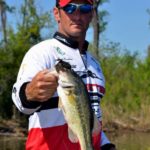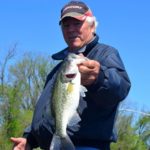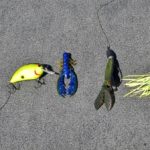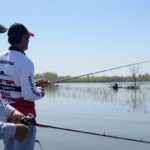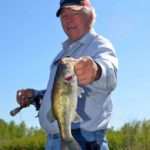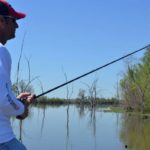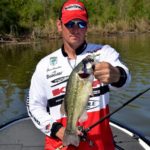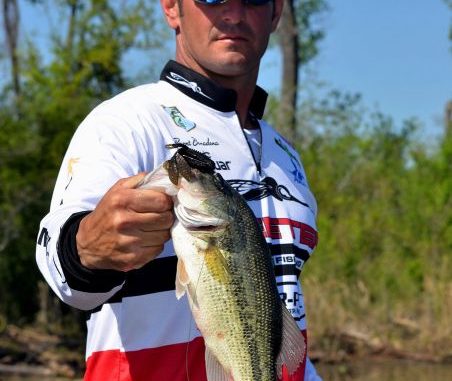
Louisiana’s Red River has been named as one of the top 25 bass-fishing destinations in the country by Bassmaster, and these anglers tell how to take advantage of the river’s healthy fishery.
Louisiana bass anglers are cantankerously serious about catching their fish. And finding locations with lots of bass action can be an emotional, recurring endeavor when planning fishing trips, vacations and — especially —bass club tournaments.
To many bass anglers however, it came as no surprise when Louisiana’s Red River was ranked as the state’s second-best bass-fishing destination behindo Toledo Bend in Bassmaster.com’s Top 100 Bass Lakes for 2014.
In the national listings, Toledo Bend ranked No. 15 and the Red River came in as No. 25. The only other Louisiana fishery that made the list was the Mississippi River Delta, which earned a 74th-place ranking.
The Red River’s ranking was well earned, one Louisiana angler said.
“The Red River system is just full of bass,” Bassmaster Open pro Brent Bonadona said.
Seventy-year-old Donaldsonville angler Richard Sherman is a veteran tournament angler who also visits the Red River frequently.
“There’s just a whole lot of fish in the Red River,” Sherman said. “In my opinion, it’s in the top four places to fish in Louisiana.”
The 39-year-old Bonadona of Baton Rouge spends a lot of time on the Red River —not only because he repeatedly fishes tournaments there but also because of the opportunities to catch a lot of fish.
One June trip exemplified that potential.
“The grass mattes were holding a lot of shad,” Bonadona said. “I spent some time punching through the grass and caught some quality fish.
“In one section where there were some lilies clustered together, I punched through these and caught a bass that weighed 8.02 pounds. I ended up with over 20 pounds of bass on that day.”
Good bass fishing in the summer on the Red is also backed up by analyzing the weights of past Bassmaster tournaments, in which daily sacks weighing 15 to 18 pounds have been common.
Bobby Reed, the inland fisheries senior technical advisor with the Louisiana Department of Wildlife and Fisheries who keeps a tab on all inland lakes in Louisiana, confirmed Bonadona’s claims.
“It’s a fine bass fishery,” Reed said. “We’ve even have had a couple of Bassmaster Classics on the Red River in Shreveport, and we are happy those folks enjoyed their time in Louisiana.”
And there are a lot of options. Running from Shreveport in Northwest Louisiana for some 260 miles to Simmesport in Central Louisiana, the Red River is divided into five pools divided by 5 lock and dam systems.
However, pools 5, 4 and 3 receive the most fishing pressure because they are close to the most-populated areas of the Red River (i.e., Shreveport and Alexandria).
Pools 5 and 4 also have many more backwater areas to concentrate fishing efforts than the other pools.
Bonadona said in April that vegetation was popping up everywhere on the river and in the backwaters.
“The river should be really colorful this summer with all the lilies and emergent grasses, and fishing should be good,” he said.
But he doesn’t spend much time in the backwaters as the summer heats up.
“In June, I like to start moving my way back to the front of all of the pockets,” Bonadona said. “Bass should be moving out onto the main river points out from the backwaters.”
However, with the cool spring Louisiana has experienced, backwater areas such as White House and Caspiana in Pool 5 might not be completely played out if surface water temperatures remain low and high waters due to rainfall swells depths of those areas.
The same can be said for Sullivan Lake and the Jungle in Pool 4.
The timing of baitfish moving out of the backwaters can be critical, so anglers might have to visit the relatively less-stained waters in these backwater areas to find bass if the river is high and muddy red.
“You should find clear water in the river in June, as long as you don’t get a rise,” Bonadona said. “In June and throughout the summer, the river can stay nice and green.”
He said there are good patches of submerged grasses in the river along the edges of the banks where you find deeper sections.
“You can flip into these areas along with the current,” he said. “You can also work any sort of ledge or drop along the river where there is grass with a spinnerbait, Lunker Lure or Bandit squarebill crankbait.”
For flipping these areas, Bonadona prefers Mr. Twister’s Poc’it Craw and the Flip’n OUT in watermelon red, although he’ll adjust colors depending on the stain of the water.
“I will be flipping through those emergent grass mats and lilies in June with the Poc’it Craw using a 1 ½-ounce weight so I can punch through the thick vegetation,” he said. “The bass will be right under the cover, especially if there is good water movement associated with baitfish in the area.”
But vegetation isn’t the only target.
“Also, there are places along the river channel edges where you can find logjams or lily jams,” Bonadona said. “Stop on these and pitch in them thoroughly, and you can get into some concentrations of bass if the current is moving into them.”
As for his tackle, Bonadona uses custom rods made especially for his preferred fishing styles (flipping, cranking, spinnerbaits/buzzbaits, and plastics).
The rest of his equipment includes Lews reels and Seaguar line — namely 12-pound test for cranking; 17 pounds for working spinnerbaits and crankbaits, and 20-pound braid for punch baits and plastics.
Sherman said his approach is to also stay in the current, but he takes a different approach.
“In the summer and beginning in June, my major focus will be fishing the river itself,” he said. “And never look past using a Lunker Lure. I use them around grassy points and a lot of the rock jetties that bass will get on in the summer.
“The fishing can be very good when the water current moves on these points and jetties.”
He said that when the locks are operated an active current is created and wing dams cause swirls of current.
“The surges in the current will move that water around, and that’s when the bass get real active,” Sherman said.
Sherman also warned that anglers should not make a common mistake of pulling up at the mouth of one cut, fishing it and then leaving quickly because of the lack of bites.
“They may operate those locks in 15 minutes, 20 minutes or even an hour later,” he said. “When that water gets moving, those bass will really get fired up. You may catch five to 10 bass in just 15 to 20 minutes if you stay at the mouth of that cut or jetty when the wing dams move.
“You want to be close to that cut when you hear that (lock) horn blow,” he said.
The angler might venture away to other locations near the locks — places that hold emergent vegetation in some backwaters. Such could include areas in pockets holding deeper water that are lightly stained, where he will fish Zoom Horny Toads and Spro Frogs above that vegetation.
“Of course, the water quality has to be relatively clear, and it helps when the baitfish are moving in and out of those cuts when the water moves,” the angler said. “But when I hear that horn go off, I’ll move back to the mouths of those cuts.”
Besides the Lunker Lure, Sherman will also cast Bandit squarebill crankbaits in the cuts, and he will often bounce them off the rock walls to find bass waiting on the edges.
As for equipment, Sherman like Bonadona uses custom rods to match his technique of fishing. Shimano reels and Stren fluorocarbon and monofilament makes up the rest of his personal fishing tackle.
Moving farther downstream, Pool 3 near St. Maurice offers another good option for bass anglers. Bonadona said his go-to approach would be similar in this stretch of the river.
“In Pool 3, there are some good little canals, oxbows and backwaters, but I would recommend anglers at first to stay in the front of them in June and the rest of the summer,” Bonadona said.
For anglers venturing into Pool 3’s canals and oxbows, Bonadona recommended dragging plastic frogs like Mr. Twister’ Hawg Frog and the Spro Frong over the vegetation.
“Where the lilies are popping up and on the pads and over grass pockets, you can catch some good bass on these frogs,” he said.
Bonadona emphasized, however, that the best summer fishing in Pool 3 occurs where there is water movement.
“Fish relate to the river current here, and that’s when spinnerbaits and crankbaits can best be used in the openings and cuts into the canals and the oxbows,” he said.
